Yevgenia Belorusets

Christina’s day
ongoing // interrupted, 2018-2021, photo series
In her photographs, Yevgenia Belorusets focuses on the most vulnerable social groups, such as the Romani and the Sinti in the Donbas region. After separatists began occupying the Donbas in 2014, the Romani, such as lawyer and human rights activist Christina Belous, were forced to leave their homes. "In our courthouse, I was suddenly running into armed men whom I knew as convicted criminals," recalls Christina. She and her sister quickly fled to Toretsk where they founded an organisation fighting for the rights of the Romani and the Sinti. Following Christina's view on the situation of the Romani and the Sinti, Belorusets' photographs attempt to capture not only human rights issues but also the topography of the Donbas, while documenting the twists and paradoxes of the every day and, above all, lending a voice to those who are not normally heard.
Yevgenia Belorusets is an artist and writer living and working in Berlin and partly Kyiv. She is the founder and editor of “Prostory”, the journal for literature and art, and a member of the curatorial group Hudrada. She works with photography and other forms at the intersection of art, literature, and social activism. Her photographic work was shown in the Ukrainian pavilion at the 56th and 59th Venice Biennale. Lucky Breaks, her first work of fiction, was given the 2020 HKW International Literature Award in Germany. For her work on War Diary, she received the 2022 Schering Stiftung Special Award for Artistic Research and the Horst Bingel Prize for Literature.
Alina Bliumis
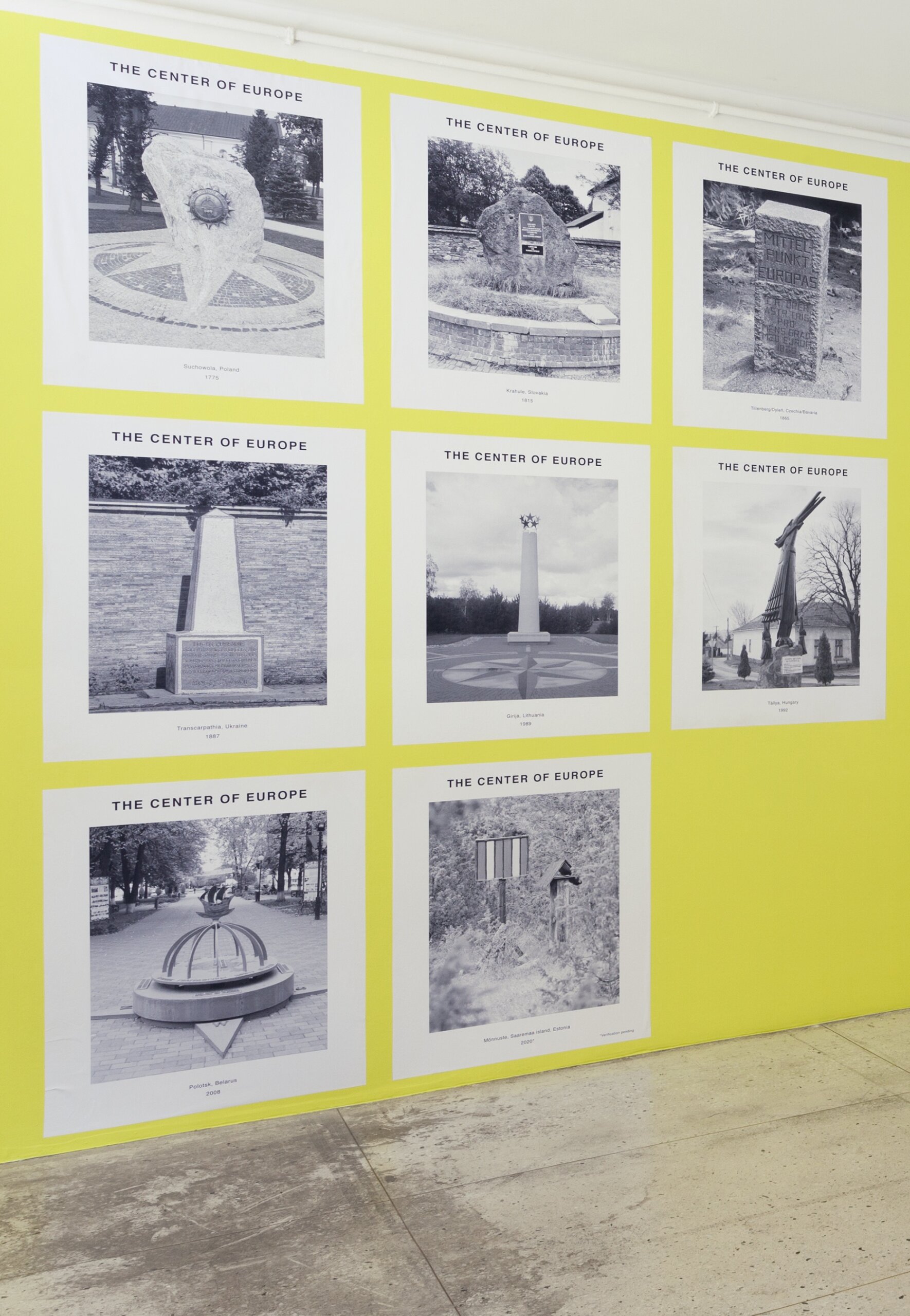
IN THE CENTRE OF EUROPE
2020, a series of 8 posters, each 72x100 cm
Installation view of Narrating Against the Grain, Kunstihoone, Tallinn, Estonia; curated by Corina L. Apostol
Photo by Paul Kuimet
Where does the heart of Europe lie? Determining the geographical centre of Europe is ambiguous due to factors such as the inclusion of certain islands and the determination of Europe's borders. At the Centre of Europe (2020) is a series of posters that explores Europe’s changing borders. Since 1775, cartographers have identified various places as the centre, including Suchowola in Poland, Kremnica in Slovakia, and a location in Ukraine. Following a reassessment in 1989, the centre was placed near Purnuškės in Lithuania. Other claims include Tállyu in Hungary, Lake Sho in Belarus, and Mõnnuste in Estonia. Each claim reflects national politics and historical changes, indicating that while the power centre of Europe is in the West, the geographical centre is much further east.
Alina Bliumis (b. Minsk, Belarus) is New York-based artist who received her BFA from the School of Visual Art in 1999 and a diploma from the Advanced Course in Visual Arts in Fondazione Antonio Ratti, Como, Italy in 2005. Her works are in various private and public collections, including MAC VAL, France; Musée national de l’histoire de l’immigration, Paris; The Victoria and Albert Museum, London; Moscow Museum of Modern Art, Russia; Bat Yam Museum for Contemporary Art, Israel; The Saatchi Collection, UK; The Harvard Business School, USA; The National Museum of American Jewish History, Philadelphia; and Missoni Collection, Italy.
Paul Chaney
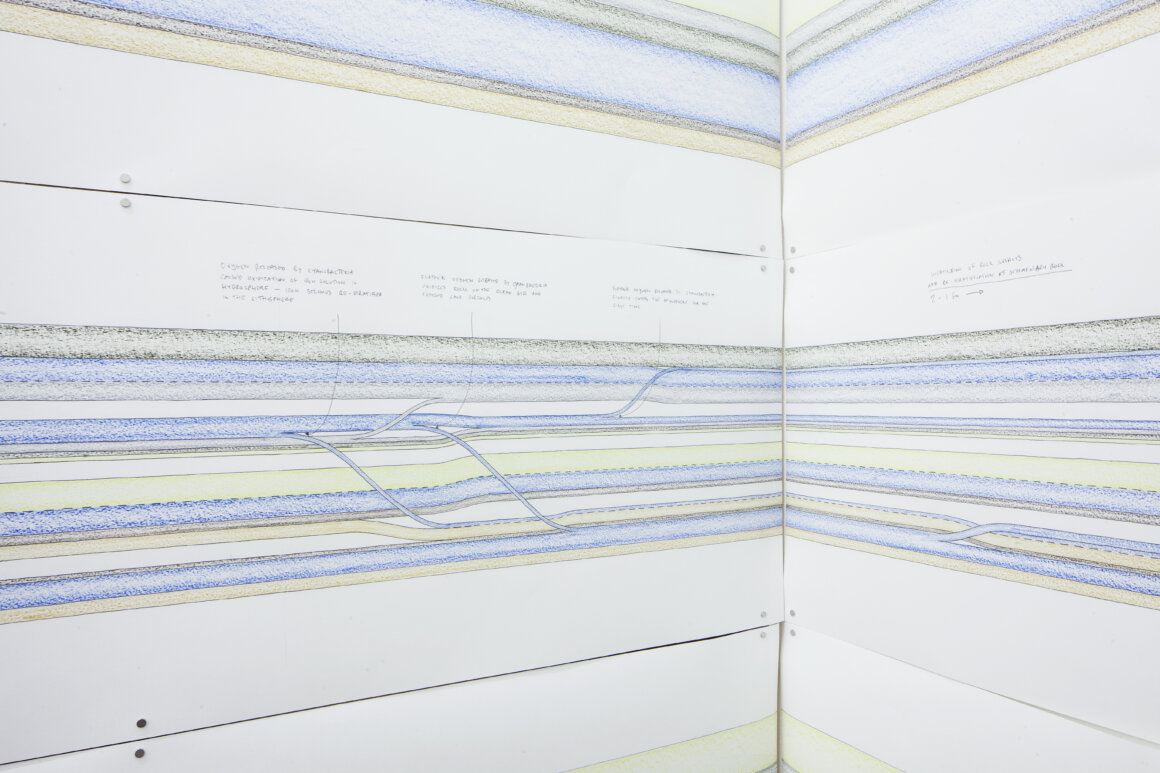
Donetsk Syndrome Diagrammatic
2011 to present day
The large-scale, handmade Donetsk Syndrome Diagrammatic ties together artistic aspects and results of the research process. On this diagram dedicated to the Donetsk region, one can follow a timeline of the 13.8 billion years of cosmic and geological development that led to the formation of one the region’s richest mineral resources. Human presence represents but a very short period on the timeline. The year 1870, when mining of this mineral wealth began, kicked off an era of an industrial metropolis populated by dispossessed immigrants. Because of the mineral wealth, this area has been at war four times since 1917. The identity crisis of the largely immigrant population subsequently enabled Russian infiltration and destabilisation, which has led to the current state of war.
Paul Cheney (*1974, United Kingdom) is an artist and researcher who lived in Donetsk 2011-2014, where he began working on the diagram about the geological and industrial development of this area. In his work he also brings to bear his great interest in ecology and agriculture, experimenting with low-carbon living and developing software programmes that are able to determine the best method for restoring nature and producing food for any local condition. He has exhibited at Bergen Kunsthalle, at Muzeum Sztuki in Łódź and at Tranzitdisplay in Prague.
Soso Dumbadze
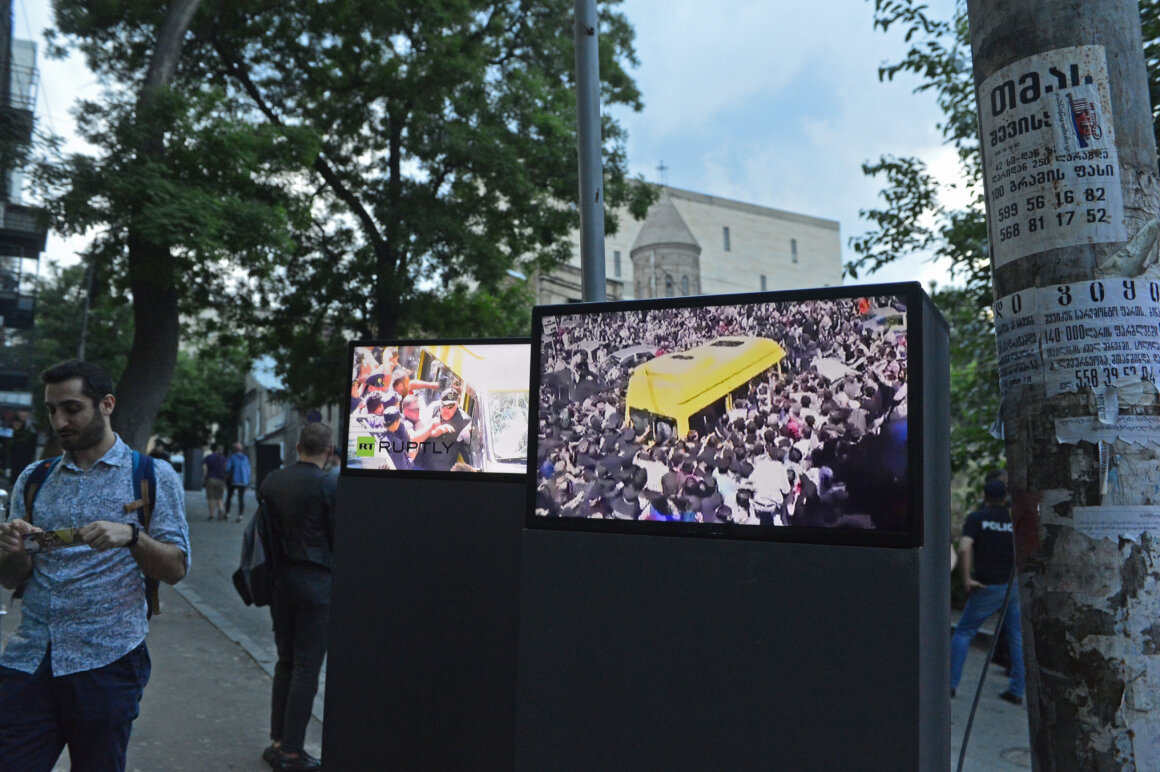
A Yellow Bus
pp. 30-31, Soso Dumbadze, 15-channel video installation, 16:9, 17:53 min., 2017
Courtesy the artist
On May 17, 2013, during the International Day Against Homophobia, a fanatical crowd of thousands, led by an Orthodox priest, attacked a group of forty citizens peacefully demonstrating for LGBT rights in Tbilisi. The demonstrators had to flee into the yellow city buses but even there, they were not safe. The aggression with which the crowd attacked the small group surprised both the protesters and the police. Soso Dumbadze created an installation, consisting of fifteen monitor screens, from footage recorded by journalists, agents of violence and those threatened. Five years later, in 2018, he planned to present this installation at the exact location where the demonstration took place, to commemorate the event. However, due to the threat of renewed attacks by fanatical crowds it was held under the protection of about 100 policemen.
Soso Dumbadze, born 1981 in Tbilisi, graduated from the Academy of Media Arts Cologne. He was awarded a PhD by the University of Fine Arts of Hamburg. He is a professor at the Georgian Institute of Public Affairs. His works were presented at the Bundeskunsthalle Bonn, Art Cologne. His films have been screened at IDFA, Dok-Leipzig, First Look NYC. 2006 he founded »Sa.Ga. Publishing for Society« publishing authors such as Walter Benjamin, Pier Paolo Pasolini, Harun Farocki. He lives in Tbilisi.
Ptuška & Keto Gorgadze
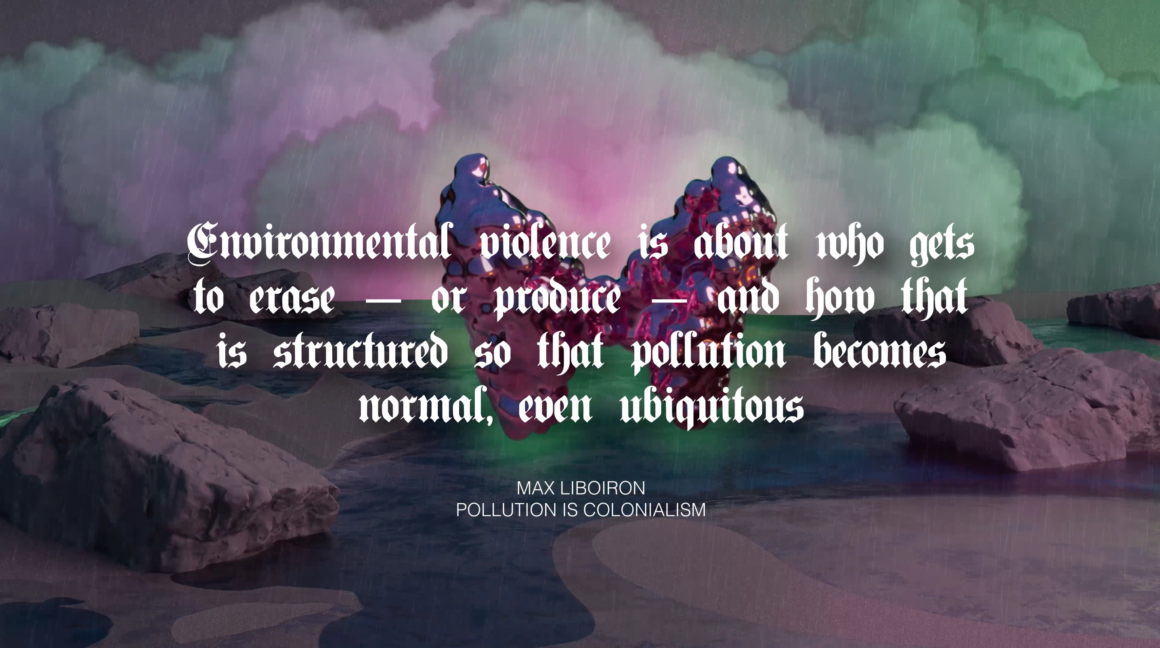
Thyroxia
2023, one-canal video, 9 min.
At first glance, it might seem like a bad dream or a fantastic story full of movie effects. But it’s not. The film Thyroxiahighlights the colonial way the Russian Empire acted towards non-Russian peoples. After the nuclear explosion at Chornobyl, radioactivity-contaminated clouds began to form and headed towards Russian territory. To prevent this, Russian planes dispersed the clouds over Belarus and Georgia. These subsequently contaminated the soil and all crops there. Due to the lack of awareness among the local population of the threat posed by the consumption of fruit and vegetables, the number of thyroid diseases has increased significantly in both Belarus and Georgia. Both filmmakers inherited the disease.
Keto Gorgadze is an alias for a writer and researcher of Georgian descent whose work is guided by decolonial and antiracist approaches and focused on the spatial policies of racialisation, the history of colonial science, and its environmental legacies.
Ptuška is an artist, born in 1992 in Belarus, who works with digital media, 3D and video. Among the themes, threading through their work, are nuclear colonialism and its remnants in the post-Soviet space, toxic landscapes, and environmental justice.
Meiro Koizumi
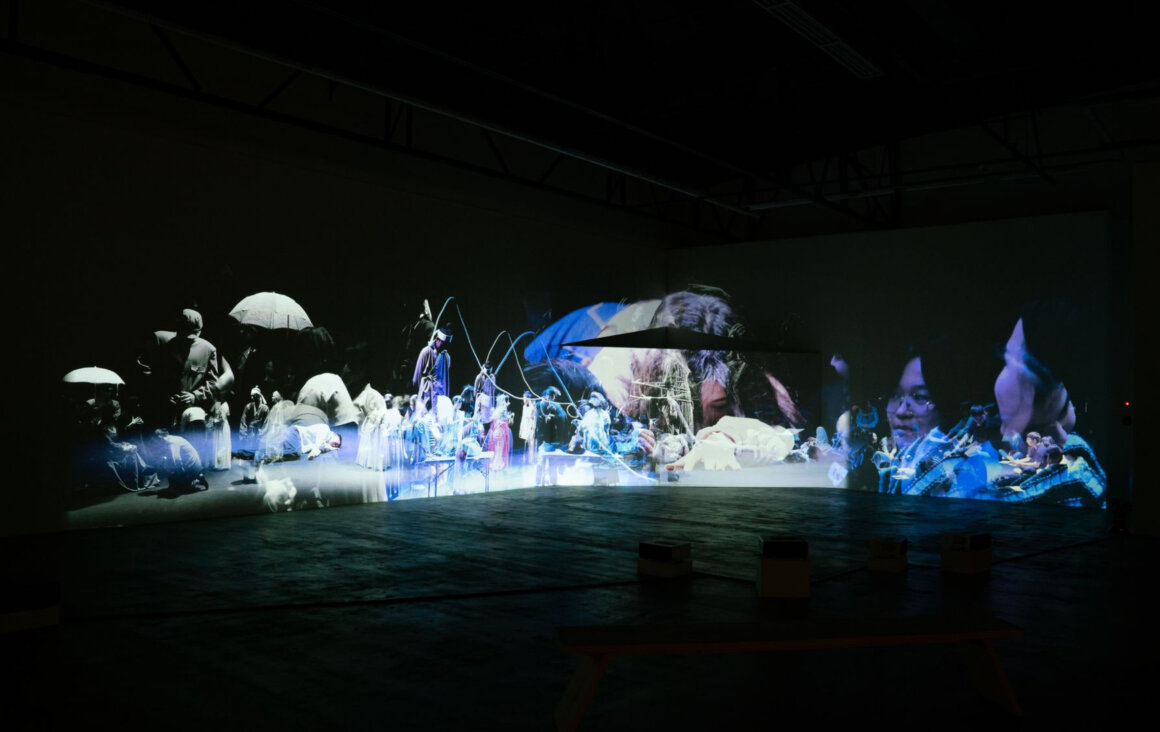
Theater of Life
5-channel video projection, 2023
When invited to participate in the 14th Gwangju Biennale in South Korea, Meiro Koizumi drew inspiration from the fate of the Koryo-Saram, Koreans living in the territory of the Soviet Union, from where they were deported by Stalin and thus deprived of their cultural identity. Koizumi then connected their fate with that of current Ukrainian emigrants who fled to South Korea after the outbreak of war in Ukraine. He held a two-day workshop with them, during which participants took on roles from the traditional Korean theatre of Goryeo, founded in 1930 in exile, as documented in surviving photographs. He then documented this process, which allowed the participants to confront their own situation and the impending loss of identity. This resulted in a poetic video projection, filled with feelings of alienation, sadness, and longing, while also radiating energy, dignity, and determination.
Through his videos, installations, and drawings, Meiro Koizumi (born in 1976 in Gunma, Japan) explores the themes of suppressed history, nationalism, power dynamics, and social expectations in Japanese society. His videos often include re-enactments or staged scenarios. His works have been exhibited at New York's MoMA (2013) and Mori Art Museum in Tokyo. His experimental theatre piece employing virtual reality, Prometheus Bound, won the Grand Prize in the 24th Art Division at the Japan Media Arts Festival. In 2021, Koizumi won the Artes Mundi Prize (Cardiff, UK). He lives in Yokohama.
Jeanna Kolesova

Memory is an Animal Which Barks With Various Mouths
2023, 2-channel video, 15:35 min.
Memory Is an Animal which Barks with Various Mouths by artist Jeanna Kolesova explores the extent to which our memory is subject to manipulation. Are we free to choose what we store in our memory and how? Or are we subject to external influences such as our parents’ memories, teachers’ stories, and official propaganda? To what extent do these influences shape the traditional myths about the heroism of our ancestors, for example, stories about heroic actions during World War II, which are popular in Russia to this day? How do they shape our ideas, dreams, wishes, and expectations? How far does our ever-present memory prevent us from accepting new perspectives? Against the background of the war in Ukraine, these are particularly topical questions that Kolesova asks in them film, using evocative documentary, live-action, and computer-animated images.
Jeanna Kolesova (born in 1988 Moorland Village, Russia) is engaged in art and research with a focus on moving images and interactive media. In 2023, they graduated with honours from the Berlin University of the Arts. Their work reflects the history and manipulation of information and the influence of imperial technologies on bodies and landscapes. Their works have been exhibited at EMOP, Kunsthalle Baden-Baden, the Museum für Fotografie in Berlin, and CalArts. They live in Berlin.
Genti Korini

Spider’s Envy
2022, film, 21 min.
In the film Spider’s Envy, Genti Korini explores the relationship between aesthetics and social imagination, examining how these elements manifest themselves in the juxtaposition of modernity with the cultural and historical framework of his native country, Albania. The artist and the critic circle around each other in a labyrinth of a modernist ruin. Set in a convoluted exploration of modernism, somewhat resonating with today’s polemics, these two adversaries pit realism against abstraction and the concept of the socialist “new man” against his bourgeois degenerate counterpart. The result is a fascinating dialogue based on the texts of Albanian art historian Alfred Uçi and a secret service document condemning the artist for his aesthetics, accompanied by almost iconic images of decaying modernist architecture.
Genti Korini was born in 1979 in Albania and studied at the University of Art and Design in Cluj, Romania. He graduated from the University of Arts in Tirana, Albania, in 2003. His work encompasses painting, sculpture, photography, and video, and is influenced by post-communism and neoliberal ideology, focusing on conceptual, political, and social impacts. His work was showcased at the 14th Manifesta in Pristina.
Diana Cam Van Nguyen
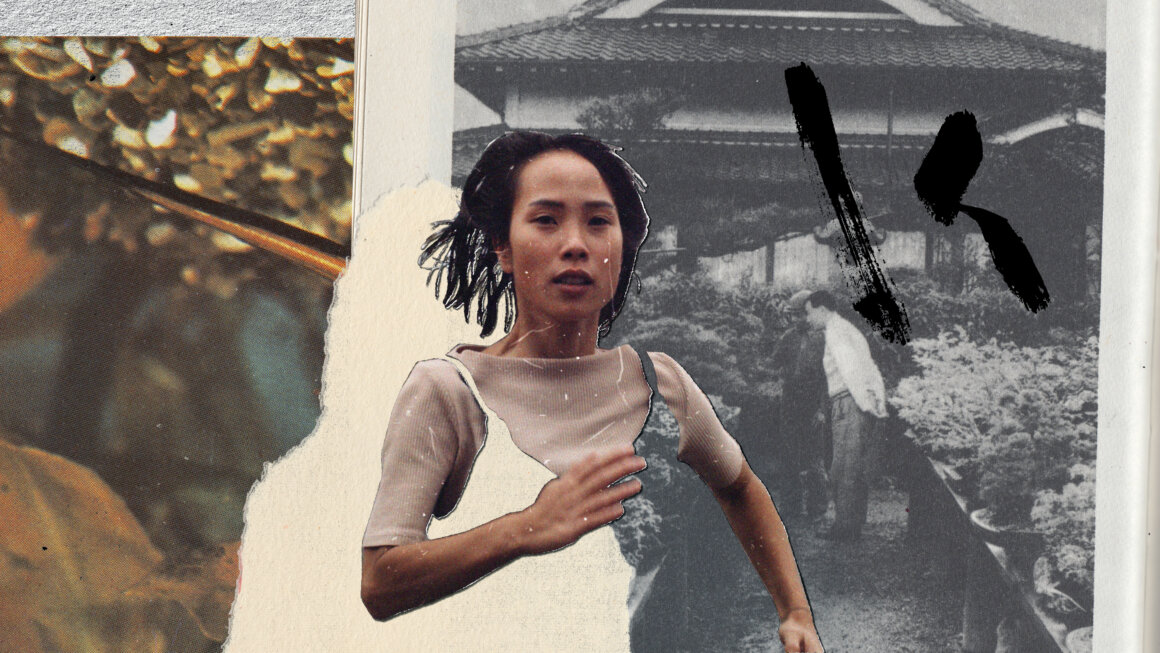
Love, Dad
2021, Film, 12:46 min.
The film Love, Dad is another example of how the personal can be intertwined with the social in a work of art. In her film, the Czech-born artist, born to parents of Vietnamese descent, comes to terms with her longing for love and recognition. She combines the letters her father wrote to her from prison when she was a child with the feelings of disappointment and disrespect she received when her father returned from prison. While the letters are full of tenderness and love, their relationship changes upon his return as her father cannot come to terms with the fact that he has not had a boy to carry on the family line, as Vietnamese cultural tradition demands. The pressure is so strong that the father leaves the family and starts a new one. The author deals with this situation with humour in a skilfully animated film and raises questions about the prejudices against women rooted in cultural traditions.
Diana Cam Van Nguyen (*1993, Czech Republic) is a film director of Vietnamese background. She graduated from the Film and TV School of the Academy of Performing Arts in Prague (FAMU) in Prague. Her short films have been selected at festivals like Locarno, Toronto, Rotterdam, Annecy and IDFA. Her latest short Love, Dad (2021) was nominated for Best Short Film at the European Film Awards 2022 and won 70+ awards from international festivals including the BFI Short Film Award, Clermont-Ferrand Connexion Award, AFI Grand Jury Award, and Toronto Honorable Mention. She lives in Prague.
Furqat Palvan-Zade

The Ball and the Polo Stick or the Book of Ecstasy
2022, single-channel video, 23 min.
Fascination with the fifteenth-century Persian manuscript The Ball and the Polo Stick, or the Book of Ecstasy takes filmmaker and researcher Furqat Palvan-Zade on a journey across transient geographies of Central Eurasia, challenging the notion of history as something static and well-defined. While commonly associated with the European upper classes, polo originated in the nomadic spaces of Central Eurasia. The film considers this sport a metaphor for the colonial history of the last few centuries. By delving into the poetic text of the Book of Ecstasy, Palvan-Zade aims not only to make a decolonial gesture of reclaiming polo’s origins but also to narrate the stories of the violent geopolitical games played by Western superpowers in Central Eurasia. The kaleidoscope of stories unfolding around the manuscript features Sufi metaphors, imperial Russian generals, a thief-turned-oligarch, and the Karabakh horse gifted by Nikita Khruschv to Queen Elizabeth II. Unpacking these narratives, Palvan-Zade tries to provide a glimpse of the particularities and commonalities that constitute the fascinating – and sometimes absurd – mosaic of today’s world.
Furqat Palvan-Zade (*1986, Tashkent) is a curator, researcher, and filmmaker. Since 2014, he has been working on the syg.ma project, which serves as a platform for projects that map the international community of writers, activists, artists, and designers. As a filmmaker, he is involved in a project exploring the ephemeral geographies and intertwined cultures of Central Eurasia. In 2023, he started a doctoral programme in the Department of Slavic Languages and Literatures at Yale University. He lives in New Haven.
Marta Popivoda
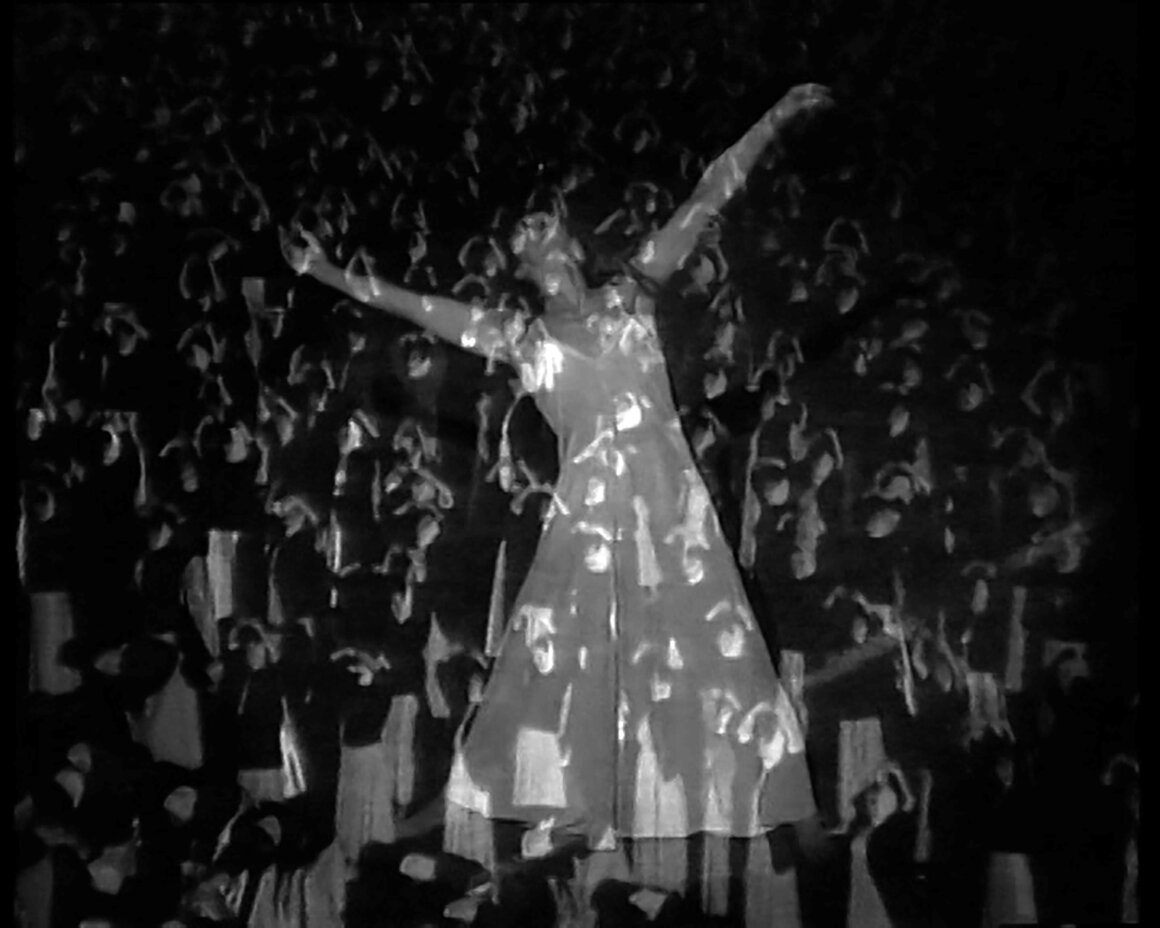
SURFACES THAT MATTER: Youth Day 1988
2022, a two-channel video installation, 20 min, in collaboration with Ana Vujanović
Marta Popivoda’s video installation is based on one of the last mass Youth Day performances in 1988, which took place at the JNA stadium in Belgrade. This performance differed significantly from the previous socialist choreographies, in which uniformed bodies fused into a collective whole. This choreography was replaced by the modern individual dance of professional dancer Sonja Vukićević. The barefoot dancer with long flowing hair fanaticised the young audience at the night-time stadium illuminated by 9,000 torches. Her dance was a symbol of individual freedom. This installation is the result of the author’s several years of study devoted to mass performances under the influence of socialist ideology and is a kind of self-reflection on the relationship of the individual to the masses. It can be understood as a look at the influence of ideology on individuality in relation to the masses or as a reflection on today’s riveting performances by pop stars.
Marta Popivoda is a filmmaker, artist, and researcher living and working between Belgrade and Berlin. Her first feature documentary, Yugoslavia, How Ideology Moved Our Collective Body, is part of the permanent collection of MoMA New York. Her second feature documentary, Landscapes of Resistance, was presented at over 50 film festivals worldwide and won around twenty awards. Popivoda’s work has been featured in major art galleries, such as Tate Modern London, MoMA New York, MAXXI Rome, M HKA Antwerp or Museum of Modern Art + MSUM Ljubljana. She received the prestigious Berlin Art Prize for visual arts from the Akademie der Künste Berlin and the Edith-Russ-Haus Award for Emerging Media Artists. Popivoda recently presented her work at the Biennale Matter of Art in Prague, the 12th Berlin Biennale, the Manifesta 14 Biennial, and the 59th Belgrade Biennale.
Karol Radziszewski
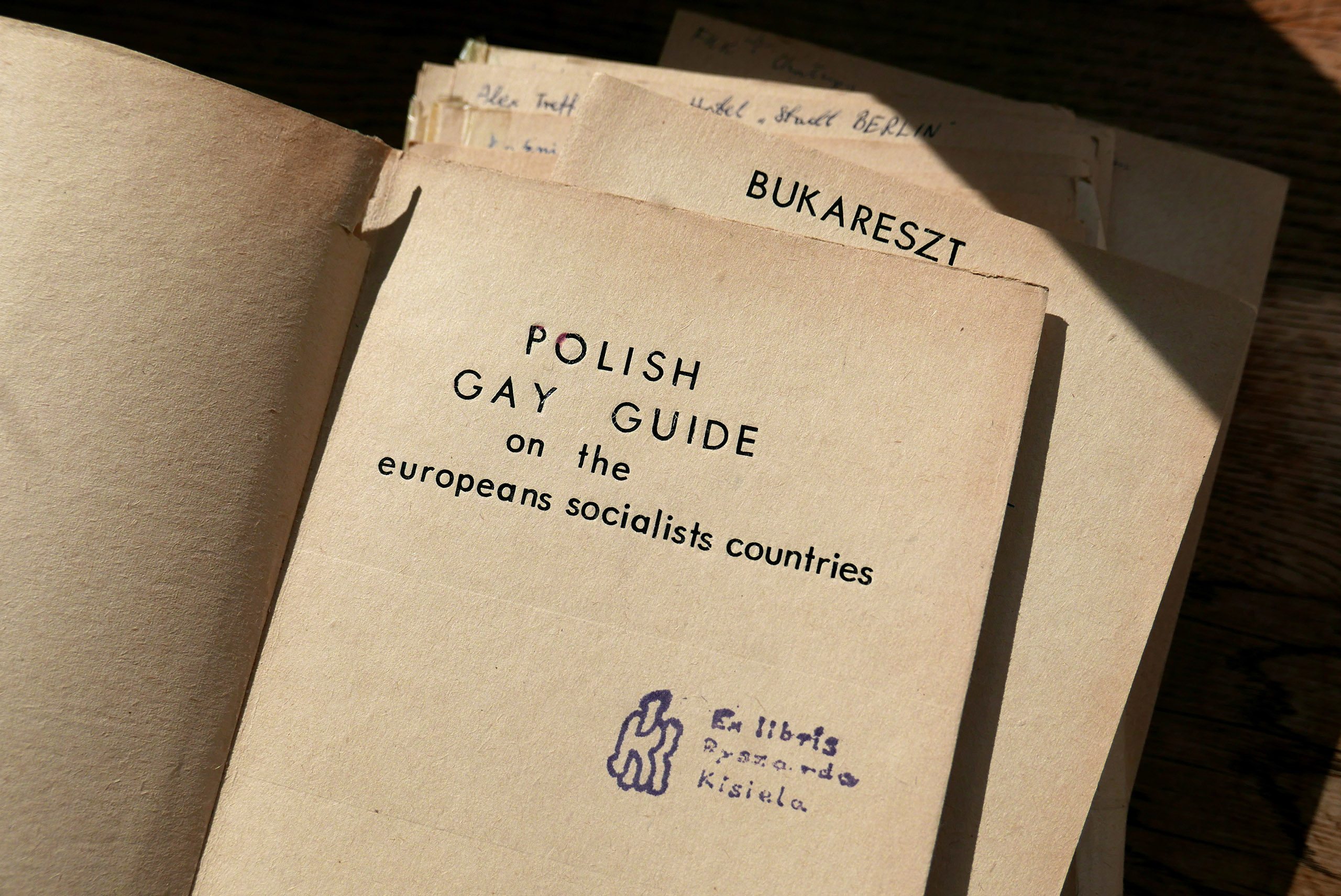
Queer Archives Institute (2015 – present) is a non-profit art and research organisation dedicated to data collection, digitisation, analysis, presentation and artistic interpretation of queer archives, with a focus on Central and Eastern Europe. The Queer Archives Institute is a long-term project open to transnational collaboration with artists, activists and academic researchers.
Karol Radziszewski (*1980, Poland) is a multidisciplinary artist who works with film, painting, photography and installation. His methodology, based on archival materials, strings together cultural, historical, religious, social and gender themes. He is the publisher and editor-in-chief of DIK Fagazine and the founder of the Queer Archives Institute.
Emilia Rigová

And the One Doesn't Stir without the Other
2021
Her work is a museum or cabinet of curiosities of herself. References include Warburg's Bilderatlas, mood walls in teenage bedrooms, Pinterest boards or the detective boards studied by art historian W. J. T. Mitchell. It is a visual-semantic concretion: gifts from friends, fetishes, souvenirs, talismans, favourite "Roma" memorabilia, miniatures, and fragments from her own works, for example, a video anthology. All this is arranged to be viewed from a distance as well as under a camera lens in a kind of mental grid of a single large shelf. It is a self-portrait, intimate and, at the same time, tightly edited. This (self-)staging and altar of her own identity is an invitation to a reading adventure and interpretive cannibalism.
Emília Rigová (*1980, Trnava) is a visual artist and researcher at the Academy of Arts in Banská Bystrica. Her works reflect her personal identity as a woman, Roma, feminist, intellectual, and activist. They often address history, collective memory, and particularly the archaeology of the Roma culture. In 2018, she became the laureate of the Oskár Čepan Award. Her solo exhibitions include Nane Oda Lavutaris / Who Will Play for Me? at Mumok in Vienna, One Doesn’t Stir without the Other at 23rd Triennale in Milano, Čohani z Koni Ajlend. Podle Bári Raklóri at Kunsthalle Bratislava, Lost Forest at ERIAC in Berlin, and Lost Identity at MQ21, Vienna. She has participated in group exhibitions such as the Kathmandu Triennale 77 in Nepal, RESIST! The Art of Resistance in Cologne, and the FutuRoma exhibition in the affiliated program of the Venice Biennale. She is also involved in exhibition, curatorial, and publishing activities.
Sam Sráč
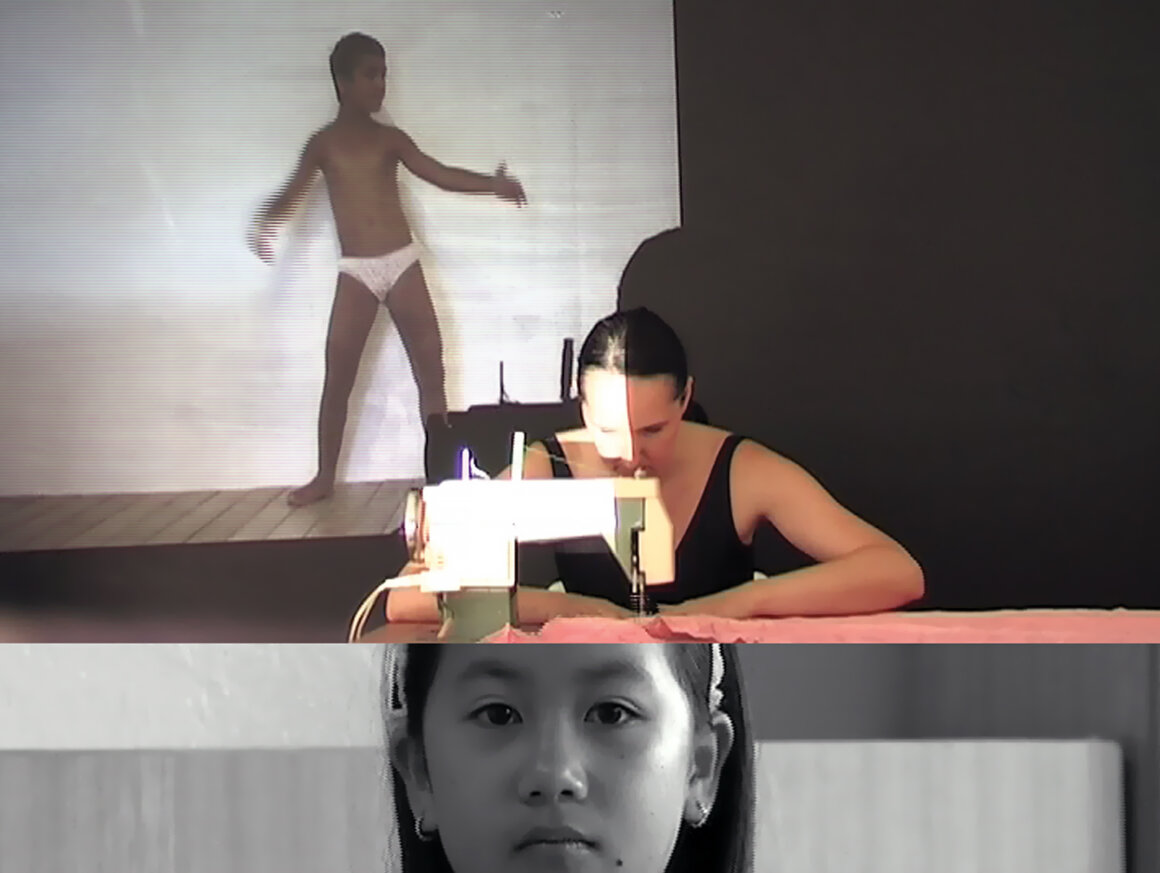
Šičky
2008, video, 5:26 min.
The installation Šičky (Seamstresses) demonstrating how personal and social elements can be combined in an artwork. Sam Sráč was sewing shirts for Soviet soldiers stationed in Czechoslovakia when she was thirteen years old. The video, composed of three horizontal strips showing the same scene repeatedly, depicts Sam sewing on a machine, with her teenage daughter dancing in the background. This image is overlaid with the faces of Vietnamese seamstresses who, under near-slave conditions, worked for years in Czechoslovakia to repay military aid provided to Vietnam during the Vietnam War. The images change in rhythm with the sewing machine, creating a compelling dynamic that is heightened by the anxiety induced by the confined space of the wooden tunnel, at the end of which the video is located.
Sam Sráč, born 1969 is artist and author. Her work involves the reassessment of the linguistic, visual, and social models that grow out of power relations from the sum of which the concept of culture is subsequently formed. She founded the sam83 gallery, she organizes artists` residencies, she publishes the independent magazine „PIŽMO“, and she is the author of the books „Vanda“, „Kuniba Likes Things in Threes", and „My Husband’s Fear“. She lives in Česká Bříza.
Minh Thang Pham

Performance with my father
2018
For the artist Minh Thang Pham, who was born in Hai Phong to parents of Vietnamese descent, the question of cultural identity has been a central theme since the very beginning of his practice. He began learning the techniques of traditional lacquer painting as part of his year-long internship at the Huế University in Vietnam. Lacquer first appeared on objects associated with burial rites to protect them against moisture 8,000 years ago. Gradually, it became a decorative element on vessels, vases, and furniture, which were also embellished with shells, eggshells, or gold. The lacquer, which is obtained from the lacquer tree that grows in Vietnam, has become a popular artistic medium for its depth of color and brilliance due to its specific properties. Modern Vietnamese lacquer painting that emerged in the first half of the twentieth century was influenced by the French colonizers. For Minh Thang Pham, lacquer painting is a way to delve deeper into the question of one's identity through traditional and handcrafted artifacts.
Minh Thang Pham (*1996, Hai Phong) completed a study placement in Vietnam in 2023–2024, which awakened his interest in the traditional lacquer painting technique sơn mài. He is currently studying at the painting studio of the Academy of Fine Arts in Prague. He is working continuously on two long-term projects – an intimate performance with his father in which he rediscovers communication in an estranged relationship, and a painting two by three metres large that he has been working on since 2021.

